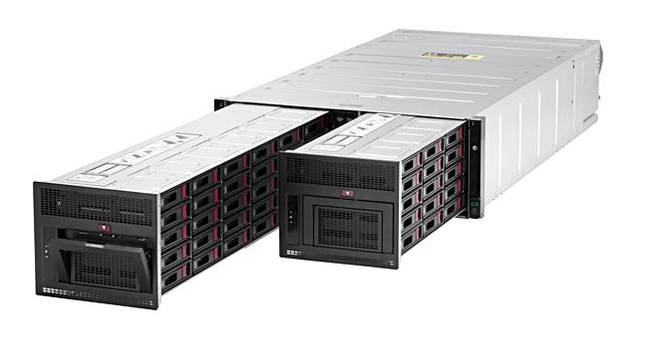This article is more than 1 year old
HPE's Apollo 'Skylaked', will get ARM-wrestling little brother next year
More Apollo 2000 and 4510 power with wee Apollo 70 entering stage
Some of HPE's supercomputer Apollo servers are Skylaked and can now say hello to an ARM-powered infant sibling.
HPE's Apollo-related announcements at SC'17 are:
- Apollo 2000 Gen 10 (G10)
- Apollo 70 with ARM CPUs
- Apollo 4510 Gen 10 for object storage
- LTO-8 tape format drives and library
We should note that the Apollo 2000 Gen 10 is not the same as HPE's Apollo 10 system. Think of current Apollo systems without the Gen 10 moniker as being Apollos using ProLiant Gen 9 servers (pre-Skylake).
The Apollo 2000 G10 has a rich (complex) set of options.
It is a 2U rackmount chassis populated with up to four half-width ProLiant G10 servers (nodes): XL170r and/or XL190r, which can be mixed in the same chassis. An r2200 chassis can have up to 12 large form factor (LFF - 3.5-inch) drives, while the r2600 chassis version can have 24 small form factor (SFF - 2.5-inch) drives.
The r2000 chassis can accomodate 2 x XL190r servers and up to two NVIDIA (V100), AMD, and Intel GPUs per server for a total of 4 GPUs oer chassis.
Alternatively, the r2000 can accomodate 4 x XL170r servers and no GPUs. You can choose between HPC/supercomputing with GPUs or without.
The r2800 chassis model uses “drive mapping” to allocate storage to each server in the chassis. The r2200 and r2600 allocate drives equally across the server nodes.
Options include Xeon Scalable processors, large memory, accelerators, and high-speed/low-latency HPC clusters and I/O interconnects.
A 42U rack can have up to 20 HPE Apollo r2000 Series chassis and up to 80 HPE ProLiant Gen10 servers per rack.
Apollo 70
There is no data sheet available for this server. We understand it uses Cavium 64-bit ARMv8-A ThunderX2 CPUs but we don't know the form factor, the CPU count, the RAM or any other technical detail.
HPE says it supports standard HPC provisioning, cluster management and performance software. It says it's built for memory-intensive HPC workloads and delivers up to 33 per cent more memory bandwidth than today's industry standard servers, without identifying which industry-standard servers it means.
The thing supports Mellanox InfiniBand and Ethernet fabric access and you can run Red Hat Enterprise Linux and SUSE Linux Enterprise Server for ARM on it.
Apollo 4510 Gen 10
This is a weird Apollo as it is not classed as an HPC-level system on HPE's Apollo page on its website.
There is an existing Apollo 4510 with a 4U chassis, one server (one or two Xeon E5-2600 v3 and v4 Series and up to 22 cores total), 1TB RAM, and up to 60 8TB 3.5-inch disk drives, meaning up to 544TB/server.
The new 4510 Gen 10 retains the 4U chassis but fits up to two Xeon Scalable Processors (Platinum, Gold or Silver) with from 4 - 26 Cores; 85 - 150W; 1.8 - 3.6 GHz. Basically that's it, the 4510 Gen 10 is a Skylaked 4510 with NVMe card support.

Apollo 4510 Gen 10
HPE says it has 16 per cent more cores than the previous generation and the NVMe cards can be used for a Scality RING metadata cache, leaving all the LFF drive bays for object data storage.
We should also note that the 4510 Gen 10 has a new front-loading, dual-drawer design with standard rack depth.
LTO-8 tape
This is straightfrward, with LTO-7 drives moving to twice-the-capacity (30TB) and 20 per cent faster (at up to 360MB/sec transfer rate) LTO-8 tapes and LTO-8-supporting (SpectaLogic) TFinity ExaScale tape library.
HPE suggests that tape is seeing a resurgence as an added layer of protection against cybercrime and ransomware attacks.
The Apollo 2000 and 4510 are available today. The LTO-8 Tape will become available in December 2017 and the Apollo 70 in 2018. ®
